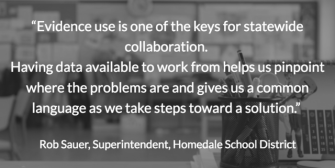This post is by Rob Sauer, Superintendent, Homedale School District, in Homedale, Idaho.
Today’s post is the practitioner perspective on Monday’s post: Tackling Teacher Recruitment and Retention Challenges in Idaho.
Exploring The Problem Of Practice Through Research And Data
Recruiting teachers is a challenge in Idaho’s rural districts.
At job fairs, new teachers often choose to apply only at schools in the more populated Boise and Treasure Valley areas, where they feel like they will get better pay or benefits. When new teachers do apply at rural schools, it’s often for specific reasons (they grew up in the area, it’s where their spouse works, etc.).
Retaining educators can also be a challenge in rural Idaho schools. Here at Homedale School District, we are doing relatively well with teacher retention because we have strong principal leadership at our three schools, which collectively serve 1,200 K-12 students.
But we also experience the same thing as many other rural districts across Idaho: When veteran teachers retire, we replace them with new teachers whom we train for two or three years and who then move on to other opportunities.
And when a district loses its only math teacher or fourth-grade teacher, you not only have to replace the person, you have to re-establish the whole program.
These challenges make it hard to build momentum, and they’re costly.
In Idaho, several groups (including rural and urban districts, the state education department, the state board of education, and colleges and universities) are now connecting to address teacher recruitment and retention.
“Idaho’s Educator Landscape” is a new report prepared for us through our research-practice partnership with REL Northwest, one of 10 federally funded regional educational laboratories. The report analyzes statewide data on the teacher workforce from 2011-12 to 2016-17 and was shared with us and other representatives from various school districts, state education agencies, and institutions of higher education in Idaho at a recent convening organized by REL Northwest (see Monday’s post for more detail).
Use Of Data and Evidence in Practice
Having access to the data and evidence in the report helps us in several ways. For example, there are only so many pieces of the financial pie to go around, and when we make our case to the Legislature, we can now present evidence directly from the report.

Second, evidence use is one of the keys for statewide collaboration. Having data available to work from helps us pinpoint where the problems are and gives us a common language as we take steps toward a solution. With the many stakeholders invested in the issue of teacher recruitment and retention in Idaho, a common set of data is a helpful starting point for identifying shared problems and solutions.
In addition, because we now have a common set of data and evidence, we can put numbers to the stories we’ve been hearing and sharing around the challenges of hiring and keeping high-quality teachers.
For example, in the anecdote I gave about novice teachers replacing veteran teachers, we now know that the number of teachers in Idaho with less than four years of experience grew from 17 to 24 percent over the last six years, while the number of teachers over retirement age has decreased from 23 to 18.5 percent.
Future Work
These sorts of challenges are too much for Idaho’s districts—rural and nonrural—to overcome by themselves. By working together with groups across the state and using data and research as a starting point and a common language, we can add to what we are already working on and ultimately do what’s best for our kids.